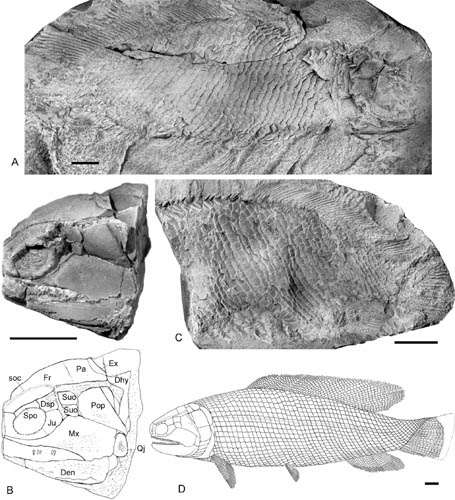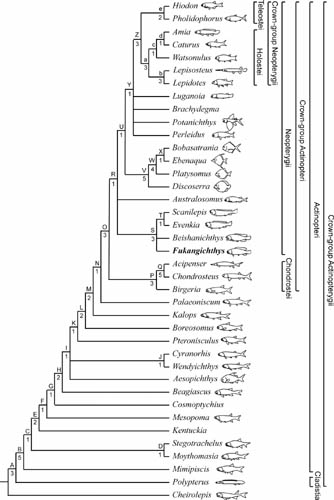Re-examination of Fukangichthys Provides New Insights into the Evolution of Early Actinopteran Fishes
The scanilepiform ray-finned fish Fukangichthys longidorsalis, from the Middle Triassic non-marine Kelamayi Formation of Xinjiang, China, was previously described incompletely, with many of its morphological characteristics unnoticed or misidentified. A study published online July 08 in Journal of Vertebrate Paleontology 34(4), presents a complete revision of this problematic taxon based on an extensive reexamination of the original fossil material, and provides new insights into the evolution of early actinopteran fishes, suggesting that the taxa used for divergence time calibrations in most molecular analyses need to be reconsidered.
The Scanilepiformes are an extinct group of ray-finned fishes, known primarily from non-marine Triassic deposits in Asia and North America, with the exception of a single species, Scanilepis dubia, from the Rhetian (Late Triassic) marine deposits of Scania, Sweden. Fukangichthys longidorsalis was first reported in 1978 from the upper part of the Kelamayi Formation (formerly the Xiaoquangou Group) of Fukang, Xinjiang, and was known as the first scanilepiform from China. Evidence from tetrapod and plant fossils suggested that the Kelamayi Formation was deposited in a freshwater environment.
Reaearchers observed the original fossil material of Fukangichthys longidorsalis, and recognized anatomical information unnoticed or misidentified previously, including a plate-like quadratojugal, a triangular dermohyal, a wedge-shaped angular, two infraorbitals, three supraorbitals, fringing fulcra on the pectoral fins, and conical, acrodin-capped teeth in the jaws.
Results of a new phylogenetic analysis confirmed Fukangichthys as a scanilepiform within the Neopterygii, and provided new insights into the evolution of early actinopteran fishes. Cosmoptychius, previously regarded as the oldest stemgroup neopterygian, and Brachydegma, previously hypothesized to be the oldest halecomorph, are here reinterpreted as a stem-group actinopteran and a stem-group neopterygian, respectively. Additionally, Discoserra, previously hypothesized in a position close to the Holostei/Teleostei split, is now recovered in a clade with Ebenaqua, Bobasatrania and Platysomus gibbosus, and is therefore phylogenetically distant from crown neopterygians.
Within the Actinopteri, most molecular analyses estimate the Chondrostei/Neopterygii split to be between 380 and 384 million years ago (Late Givetian to Early Frasnian,Middle to Late Devonian) and the Holostei/Teleostei split within the Neopterygii to be between 362 and 365 million years ago (Famennian, Late Devonian) based on calibrations from the fossil actinopterans Cosmoptychius and Brachydegma. “Morphological analyses have not reached a consensus on the timing of these splits, and phylogenetic relationships among early actinopterans remain highly unstable. The implication of this revised topology, in and around the split between the two principal extant actinopteran lineages, is that the taxa used for divergence time calibrations need to be reconsidered”, said lead author Dr. XU Guang-hui of the IVPP.
This study was supported by the National Natural Science Foundation of China. Dr. GAO Ke-Qin, School of Earth and Space Sciences of Peking University, and Dr. John Finarelli, University College Dublin, Ireland, are other authors of the study.

Fig.1 Fukangichthys longidorsalis (A – C) and reconstruction (D). Scale bars equal 10 mm. (Image by XU Guang-hui)

Fig.2 New analysis showing phylogenetic relationships of Scanilepiformes within the broader context of the Actinopterygii. (Image by XU Guang-hui)
Download attachments: